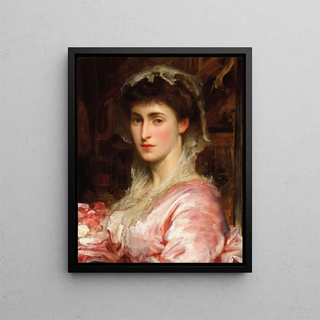Art print | Portrait of May Sartoris Mme Henry Evans Gordon - Frederic Leighton


View from behind

Frame (optional)
The "Portrait of May Sartoris" is an iconic art print by Frederic Leighton, a master of the Pre-Raphaelite movement and Victorian aesthetics. Painted at the end of the 19th century, this canvas captures not only the beauty of his model but also the essence of an era where art and life intertwined intimately. The depiction of May Sartoris, wife of an influential intellectual, evokes both delicacy and strength of a personality that left its mark on its time. Through this art print, Leighton invites us to immerse ourselves in a universe where beauty is both an ideal and a tangible reality.
Style and uniqueness of the art print
Leighton's style is characterized by meticulous attention to detail and mastery of colors that give his works unparalleled depth and richness. In the "Portrait of May Sartoris," the finesse of the features and the gentle expression of the model reveal a particular sensitivity. The drapery of the dress, carefully rendered, seems almost alive, while the neutral background allows the figure to stand out gracefully. The artist uses light to emphasize contours and texture, creating an intimate atmosphere where the viewer is invited to contemplate the penetrating gaze of the muse. This art print is not just a simple representation; it tells a story, that of a woman both modern and rooted in her time.
The artist and his influence
Frederic Leighton, born in 1830, is one of the major figures of British art. His artistic journey was marked by training abroad, notably in Italy, where he absorbed the techniques of old masters. Leighton is recognized for his ability to fuse classical and contemporary elements, thus creating a unique style that influenced many artists of his era. His engagement in the arts was not limited to painting; he also played a key role in promoting decorative arts and artistic education. Through his works, he captured the essence of human emotions and mythological stories, while incorporating modern themes. The "Portrait of May Sartoris" is a perfect illustration of this duality, where beauty

Matte finish

View from behind

Frame (optional)
The "Portrait of May Sartoris" is an iconic art print by Frederic Leighton, a master of the Pre-Raphaelite movement and Victorian aesthetics. Painted at the end of the 19th century, this canvas captures not only the beauty of his model but also the essence of an era where art and life intertwined intimately. The depiction of May Sartoris, wife of an influential intellectual, evokes both delicacy and strength of a personality that left its mark on its time. Through this art print, Leighton invites us to immerse ourselves in a universe where beauty is both an ideal and a tangible reality.
Style and uniqueness of the art print
Leighton's style is characterized by meticulous attention to detail and mastery of colors that give his works unparalleled depth and richness. In the "Portrait of May Sartoris," the finesse of the features and the gentle expression of the model reveal a particular sensitivity. The drapery of the dress, carefully rendered, seems almost alive, while the neutral background allows the figure to stand out gracefully. The artist uses light to emphasize contours and texture, creating an intimate atmosphere where the viewer is invited to contemplate the penetrating gaze of the muse. This art print is not just a simple representation; it tells a story, that of a woman both modern and rooted in her time.
The artist and his influence
Frederic Leighton, born in 1830, is one of the major figures of British art. His artistic journey was marked by training abroad, notably in Italy, where he absorbed the techniques of old masters. Leighton is recognized for his ability to fuse classical and contemporary elements, thus creating a unique style that influenced many artists of his era. His engagement in the arts was not limited to painting; he also played a key role in promoting decorative arts and artistic education. Through his works, he captured the essence of human emotions and mythological stories, while incorporating modern themes. The "Portrait of May Sartoris" is a perfect illustration of this duality, where beauty






